Groundwater Depletion in an Urban Environment under Semiarid Climate and Persistent Drought–City of Marrakesh (Morocco)
Abstract
:1. Introduction
2. Materials and Methods
2.1. Study Area and Context
- -
- The first is that of Tensift, oriented east–west and located in the western and central part of the Haouz Plain. The Tensift River is fed by several tributaries coming down for the north side of the High Atlas Mountains. These tributaries are: R’dat, Zat, Ourika, Rheraya and N’Fis (west to east).
- -
- The second is that of R’dat which drains the eastern part of the Haouz Plain.
- -
- The average water supply of these watercourses is about 887.89 million m3/year. The tributaries of the Tensift account for 70% of the total contribution of water supply (620.15 million m3/year–19.67 m3/s). The higher flow rate comes from Ourika (6.39 m3/s) and N’fis (5.4 m3/s). The remaining 30% (267.74 million m3/year–8.48 m3/s) of water supply is from the eastern hydrological systems of Haouz Plain.
- -
- The lithological, geometrical and structural heterogeneities of the shallow aquifer of the Haouz Plain involve a high spatial variability in the hydrodynamic parameters average value in the study area:
- -
- The transmissivity of the Haouz aquifer presents a significant dispersion with values ranging from 1.10−4 m2/s to 4.10−2 m2/s (average value in the study area 0.0063 m2/s).
- -
- The hydraulic conductivity is less heterogeneous than the transmissivity. Ninety-five percent of hydraulic conductivity values are between 7.10−4 m/s to 1.10−3 m/s (0.00044 m/s).
- -
- The storage coefficient varies between 0.1 and 26% (4.4%). This coefficient is identical to the specific yield as the Haouz aquifer is unconfined.
2.2. Water Table Evolution under the Impact of Increasing Demand
- -
- The measurements were done with a manual piezometric probe (Figure 6).
- -
- For each observation well, a measuring point (MP) was established.
- -
- GPS, topographic map and satellite imaging were used to determine the exact location of each well (MP) and the corresponding altitude of land–surface datum (LSD).
- -
- A correction length was made if the MP was above (−) or below (+) the LSD. It should be noted here that all observation wells are vertical.
- -
- All the measurements were made by ensuring that the pumping is off for a sufficient period so as to enable the water table to regain its natural static level.
- -
- The water table level was calculated according to the following formula:
3. Results
3.1. Marrakesh Water Table in 2019
- -
- Traditional hand-dug wells: the diameters of these wells lie between 1.20 and 2.90 m. Typically, these are shallow and lined with stones, concrete or brick to prevent their collapse.
- -
- Drilled wells: constructed by percussion or rotary-drilling machines, with a diameter smaller than traditional wells, not exceeding 75 cm. These wells are equipped with casing.
3.2. Water Table Trend from 1962 to 2019
4. Discussion
4.1. Understanding the Current Water Table Behaviour
4.2. The Water Table Decline, a General Trend
5. Conclusions
Author Contributions
Funding
Institutional Review Board Statement
Informed Consent Statement
Data Availability Statement
Acknowledgments
Conflicts of Interest
References
- Lachir, A.; Bounoua, L.; Zhang, P.; Thome, T.; Messouli, M. Modeling the Urban Impact on Semiarid Surface Climate: A Case Study in Marrakesh, Morocco. Can. J. Remote Sens. 2016, 42, 379–395. [Google Scholar] [CrossRef]
- Bigio, A.G. The Sustainability of Urban Heritage Preservation. The Case of Marrakesh. In Inter-American Development Bank; 1300 New York Ave. NW: Washington, DC., USA, 2010. [Google Scholar]
- Nakhli, A. La Mobilité Urbaine à Marrakech: Enjeux et Perspectives. Ph.D. Thesis, Université Bordeaux Montaigne, Bordeaux, France, 2015. [Google Scholar]
- Colsado, E. Étalement Urbain et Opérations Immobilières Périurbaines Pour Classes Moyennes à Marrakech: Production, Peuplement et Modes D’habiter. Ph.D. Thesis, Université François-Rabelais, Tours, France, 2015. [Google Scholar]
- Bolzman, C.; Fokkema, T.; Guissé, I.; DalenStarting, D.V. Starting a new life in the South? Swiss, Dutch and Flemish ageing in Morocco: A lifecourse perspective. Ageing Soc. 2021, 41, 1240–1266. [Google Scholar] [CrossRef]
- Twil, A.; Bidan, M.; Bencharef, O.; Kaloun, S.; Safaa, L. Exploring destination’s negative e-reputation using aspect based sentiment analysis approach: Case of Marrakesh destination on TripAdvisor. Tour. Manag. Perspect. 2021, 40, 100892. [Google Scholar]
- Lghoul, M.; Kchikach, A.; Hakkou, R.; Zouhri, L.; Guerin, R.; Bendjoudi, H.; Teíxido, T.; Penã, J.A.; Enriqué, L.; Jaffal, M.; et al. Etude géophysique et hydrogéologique du site minier abandonné de Kettara (région de Marrakech, Maroc): Contribution au projet de rehabilitation. Hydrol. Sci. J. 2012, 57, 370–381. [Google Scholar] [CrossRef] [Green Version]
- Kahime, K.; Ben Salem, A.; El Hidan, A.; Messouli, M.; Chakhchar, A. Vulnerability and Adaptation Strategies to Climate Change on Water Resources and Agriculture in Morocco: Focus on Marrakesh-Tensift-Al Haouz Region. Int. J. Agric. Environ. Res. 2018, 4, 58–77. [Google Scholar]
- Hssaisoune, M.; Bouchaou, L.; Sifeddine, A.; Bouimetarhan, I.; Chehbouni, A. Moroccan Groundwater Resources and Evolution with Global Climate Changes. Geosciences 2020, 10, 81. [Google Scholar] [CrossRef] [Green Version]
- Choukrani, G.; Hamimsa, A.; Saidi, M.; Babqiqi, A. Diagnosis and Future Projection of Climate Change in Arid Zone. Case of Marrakesh-Safi Region (Morocco). LARHYSS J. 2018, 36, 49–63. [Google Scholar]
- Burke, J.J. Groundwater for irrigation: Productivity gains and the need to manage hydro-environmental risk. In Intensive Use of Groundwater—Challenges and Opportunities; Swets & Zeitlinger B.V.: Lisse, The Netherlands, 2002; pp. 59–91. [Google Scholar]
- Noori, R.; Maghrebi, M.; Mirchi, A.; Tang, Q.; Bhattarai, R.; Sadegh, M.; Noury, M.; Torabi Haghigh, A.; Kløve, B.; Madani, K. Anthropogenic depletion of Iran’s aquifers. Proc. Natl. Acad. Sci. USA 2021, 118, e2024221118. [Google Scholar] [CrossRef]
- Barzkar, A.; Najafzadeh, M.; Homaei, F. Evaluation of Drought Events in Various Climatic Conditions using Data-Driven Models and A Reliability-Based Probabilistic Model. Nat. Hazards 2021. [Google Scholar] [CrossRef]
- Saddou, H. Tourisme à Marrakech: Impacts économiques, socioculturels et environnementaux éminents. Espace Géographique Société Maroc. 2009, 28/29, 221–251. [Google Scholar]
- Belkouadssi, M. Gestion intégrée des eaux urbaines de la ville de Marrakech. In Proceedings of the Center of Mediterranean Integration Conference, Marseille, France, 9 January 2017. [Google Scholar]
- Ruf, T.; Kleiche-Dray, M. Les eaux d’irrigation du Haouz de Marrakech: Un siècle de confrontations des modèles de gestion publics, privés et communautaires. EchoGéo 2018, 43, 1–42. [Google Scholar] [CrossRef] [Green Version]
- Abourida, A.; Simonneaux, V.; Errouane, S.; Berjami, B.; Sghir, F. Estimation des volumes d’eau pompés dans la nappe pour l’irrigation (plaine du Haouz, Marrakech, Maroc). Comparaison d’une méthode statistique et d’une méthode basée sur l’utilisation de la télédétection. Rev. Sci. L’Eau 2009, 22, 1–13. [Google Scholar]
- El Fadeli, S.; Bouhouch, R.R.; Benmazhar, H.; Barkouch, Y.; Zimmermann, M.B.; Sedki, A. Characterization of physico-chemical and mineralogical quality of drinking water from four areas of the city of Marrakesh, Morocco. J. Mater. Environ. Sci. 2015, 6, 2437–2445. [Google Scholar]
- Hakkou, R.; Wahbi, M.; Bachnou, A.; Elamari, K.; Hanich, L.; Hibti, M. Impact of Marrakesh (Morocco) municipal landfill on water resources. J. Mater. Environ. Sci. 2001, 60, 325–336. [Google Scholar]
- Lyakhloufi, S.; Ouazzani, N.; Er Rouane, S.; Hassani, L.; El Hebil, A. Impact de l’utilisation des eaux usées urbaines brutes sur la qualité de l’eau d’une nappe alluviale près de Marrakech (Maroc). Bull. Soc. Hist. Nat. 1999, 135, 59–70. [Google Scholar]
- Moumou, A. Contribution à L’étude de Fonctionnement d’une Décharge, Approche de Caractérisation Sur Volume du Comportement Hydraulique et Physico-Chimique d’un Déchet Type et Essai de Simulation. Ph.D. Thesis, Fac. Sc., Cadi Ayyad University, Marrakesh, Morocco, 1997. [Google Scholar]
- Choua, S.; Boussaa, S.; El Gharmali, A.; Boumezzough, A. Impact of irrigation with wastewater on accumulation of heavy metals in soil and crops in the region of Marrakesh in Morocco. J. Saudi Soc. Agric. Sci. 2019, 18, 429–436. [Google Scholar]
- Boukhoubza, F.; Ait Boughrous, A.; Yacoubi-Khebiza, M.; Jail, A.; Hassani, L.; Idrissi, L.; Nejmeddine, A. Impact of olive oil wastewater on the physicochemical and biological quality of groundwater in the Haouz plain, south of Marrakesh (Morocco). Environ. Technol. 2008, 29, 959–974. [Google Scholar] [CrossRef] [PubMed]
- Lyakhloufi, S. Vulnérabilité et Risque de Pollution de la Nappe Phréatique du Haouz de Marrakech. Ph.D. Thesis, Fac. Sc., Cadi Ayyad University, Marrakesh, Morocco, 2001. [Google Scholar]
- Fakir, Y.; Limam, N. Quantitative groundwater zoning of the Haouz aquifer (Morocco). In Proceedings of the Seventeenth International Water Technology Conference, IWTC17. Istanbul, Turkey, 5–7 November 2013. [Google Scholar]
- Abourida, A.; Errouane, S.; Leduc, C.; Chehbouni, G. Impact de la modernisation agricole sur l’évolution piézométrique de la nappe phréatique du Haouz (Maroc central). In Proceedings of the Séminaire sur la Modernisation de L’agriculture Irriguée, Rabat, Morocco, 19–23 April 2004. [Google Scholar]
- Morris, B.L.; Lawrence, A.R.L.; Chilton, P.J.C.; Adams, B.; Calow, R.C.; Klinck, B.A. Groundwater and Its Susceptibility to Degradation: A Global Assessment of the Problem and Options for Management; Early Warning and Assessment Report Series, RS. 03-3; United Nations Environment Programme: Nairobi, Kenya, 2003. [Google Scholar]
- Sinan, M.; Moumtaz, R. An extension to the DRASTIC model to assess groundwater vulnerability to pollution: Application to the Haouz aquifer of Marrakesh (Morocco). Environ. Geol. 2009, 57, 349–363. [Google Scholar] [CrossRef]
- Ferrandini, J.; Ferrandini, M. Evidence of Lias and middle Jurassic of the northern High-Atlas of Marrakesh (Morocco). Paleogeographical History. C. R. L Acad. Sci. Ser. II 1984, 299, 351–356. [Google Scholar]
- Ferrandini, J.; Le Marrec, A. The Jurassic to Paleogene cover of the High Atlas of Marrakesh is allochthonous in the “zone des cuvettes” of Ait Ourir (Maroc). C. R. L Acad. Sci. Ser. II 1982, 295, 813–816. [Google Scholar]
- Sinan, M. Méthodologie D’identification, D’évaluation et de Protection des Ressources en Eau des Aquifères Régionaux par Couplage des SIG, de la Géophysique et de la Géostatistique Application à L’aquifère du Haouz de Marrakech (Maroc). Ph.D. Thesis, Ecole Mohammadia d’Ingénieurs, Rabat, Morocco, 2000. [Google Scholar]
- Ait El Mekki, O.; Laftouhi, N.-E. Combination of a geographical information system and remote sensing data to map groundwater recharge potential in arid to semi-arid areas: The Haouz Plain, Morocco. Earth Sci. Inform. 2006, 9, 465–479. [Google Scholar] [CrossRef]
- Kumar, V. Optimal contour mapping of groundwater levels using universal kriging—A case study. Hydrol. Sci. J. 2007, 52, 1038–1050. [Google Scholar] [CrossRef]
- Kaur, S.; Aggarwal, R.; Soni, A. Study of water-table behaviour for the Indian Punjab using GIS. Water Sci. Technol. 2011, 63, 1574–1781. [Google Scholar] [CrossRef] [PubMed]
- Saidi, M.E.; Bouloumou, Y.; Ed-Daoudi, S.; Aresmouk, M.E. Les crues de l’oued Issil en amont de Marrakech (Maroc), un risque naturel recurrent—The floods of the Wadi Issil upstream of Marrakesh (Morocco), a recurring natural hazard. Eur. Sci. J. 2013, 9, 189–208. [Google Scholar]
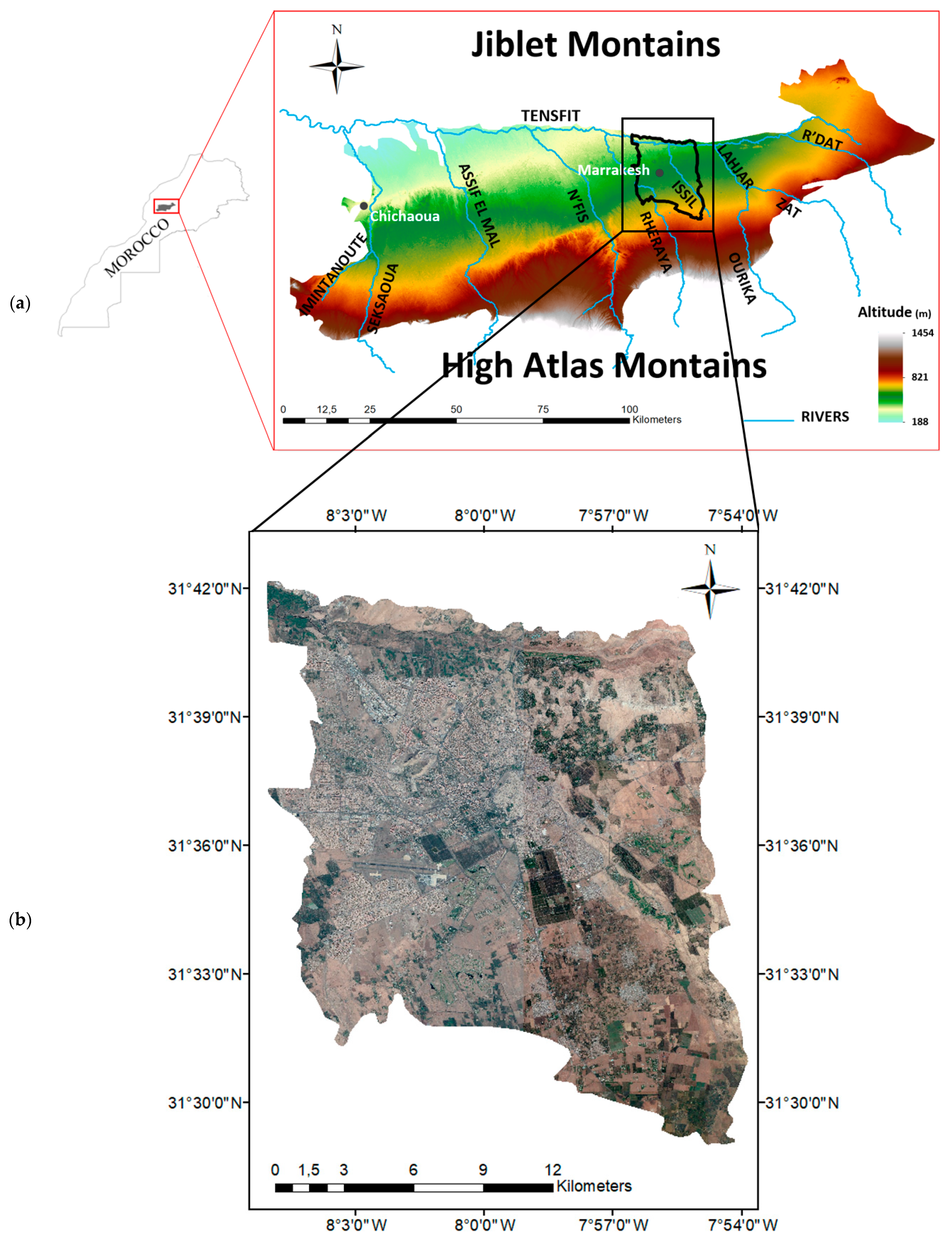
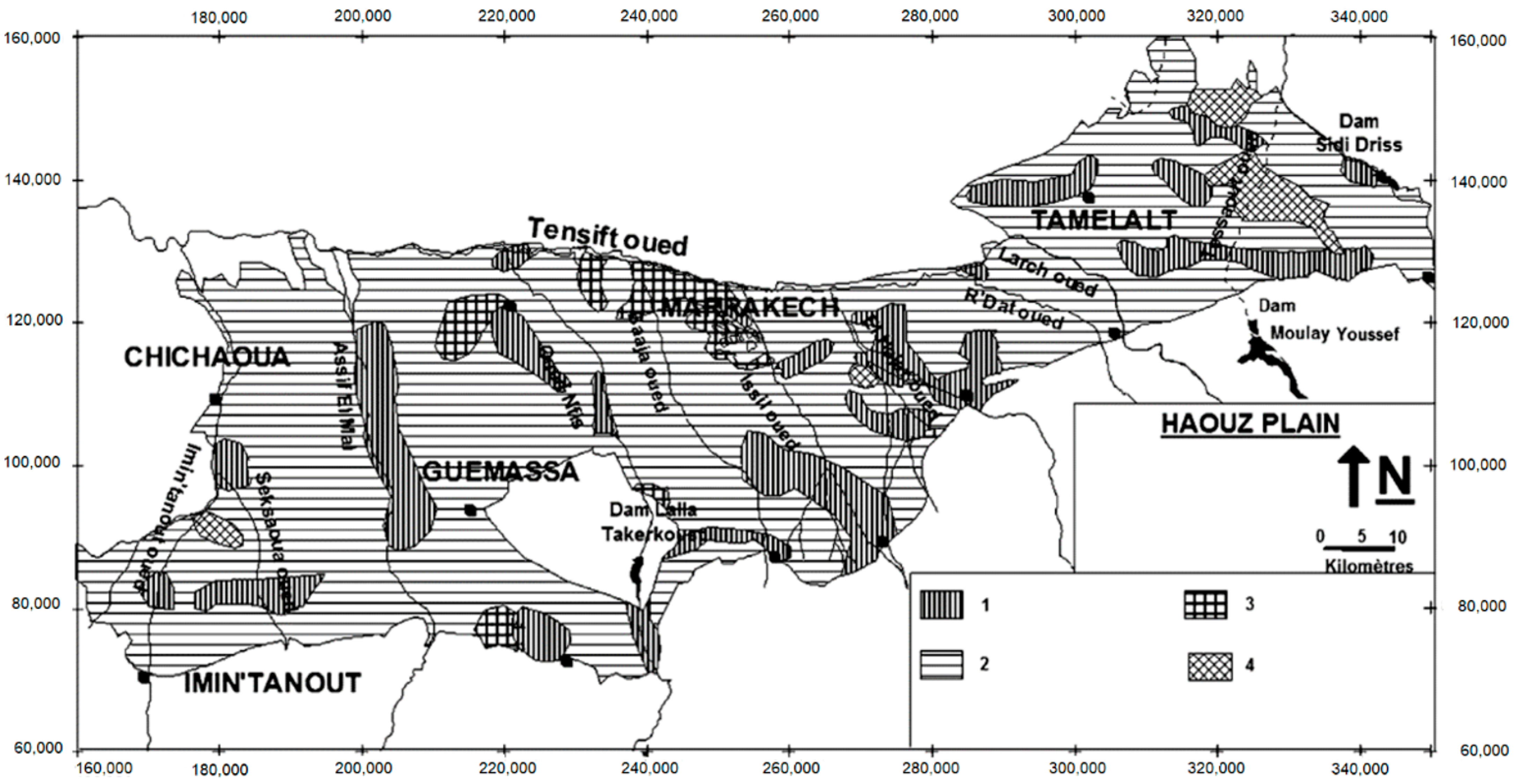
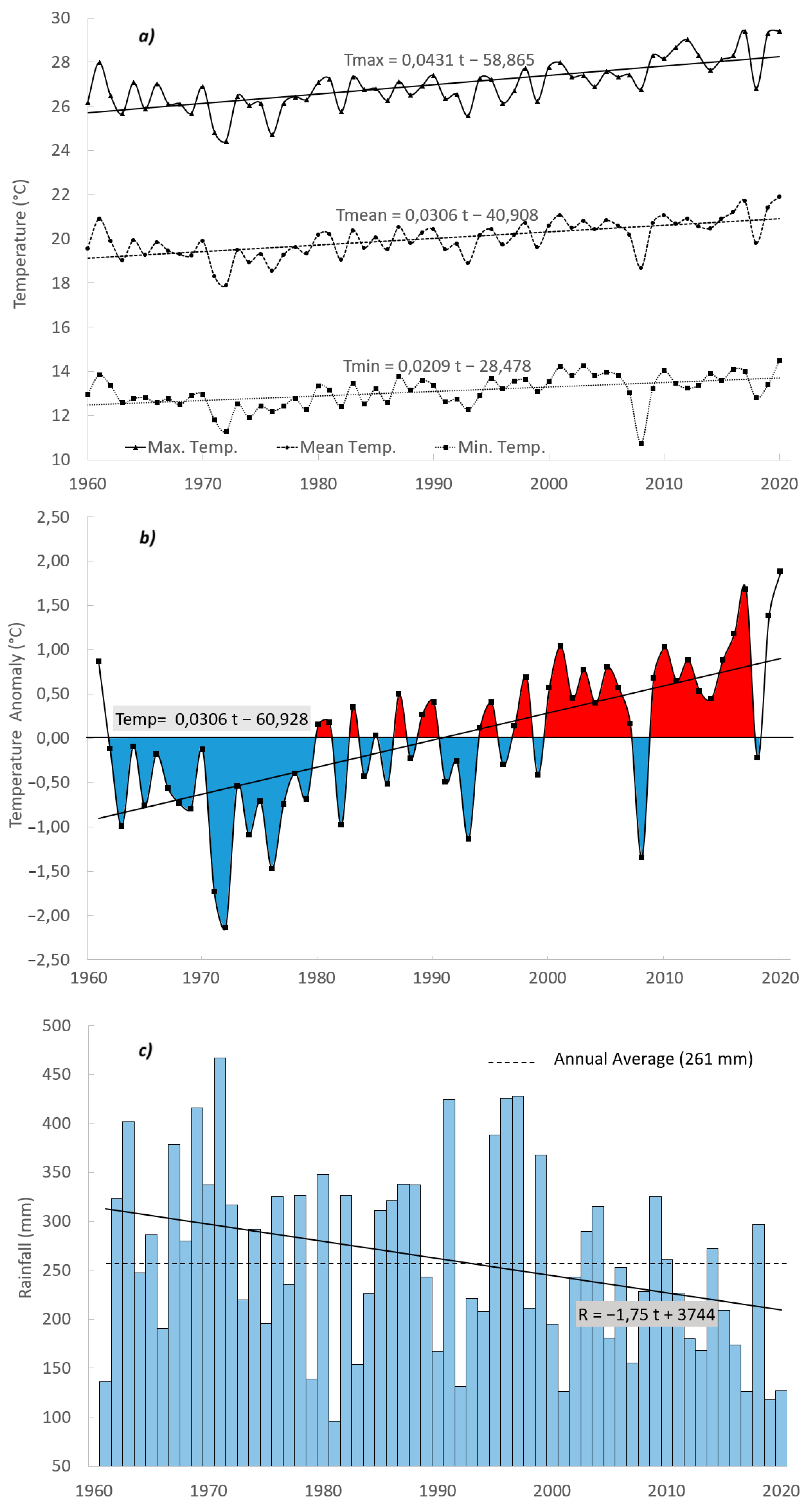
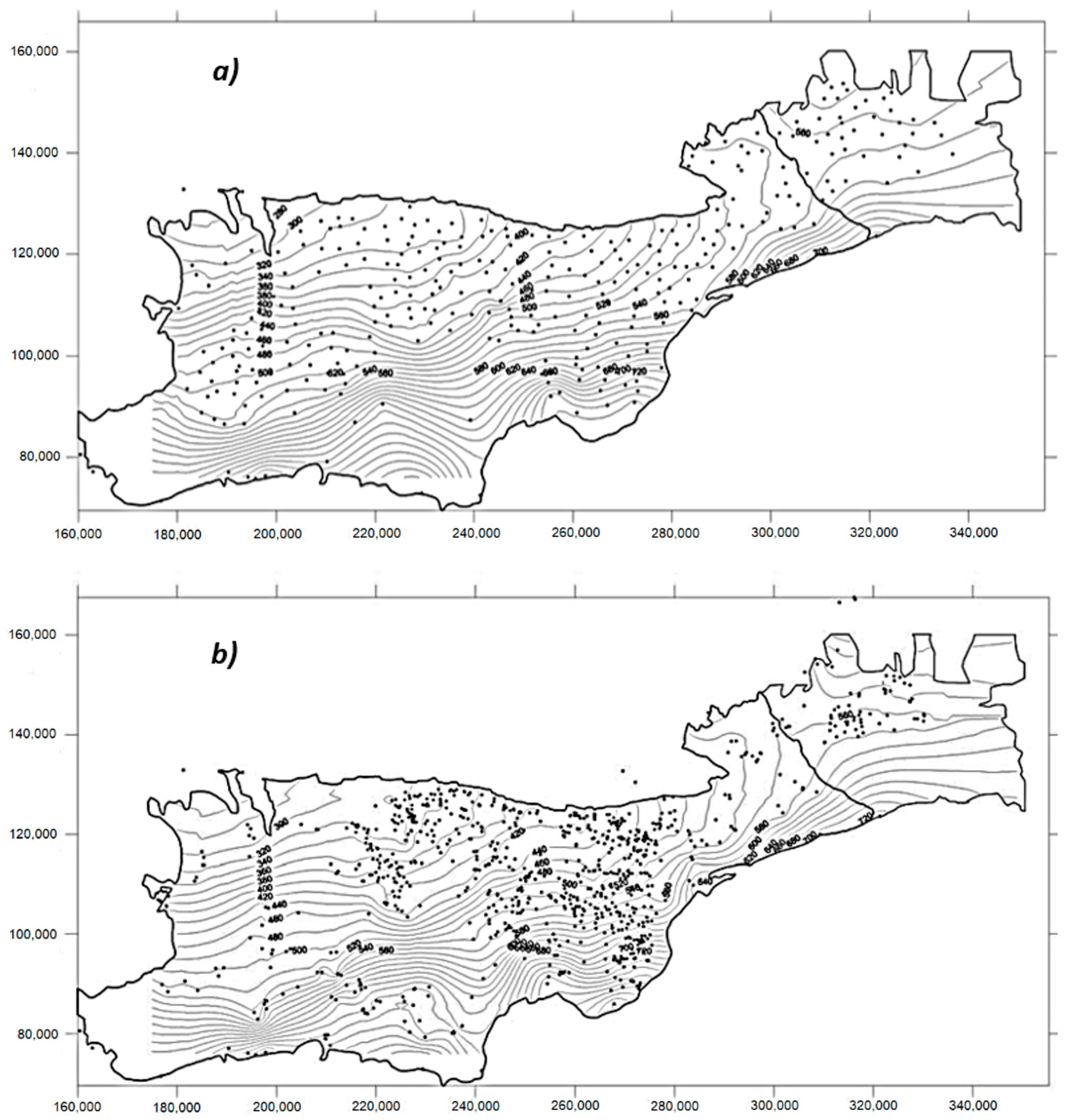
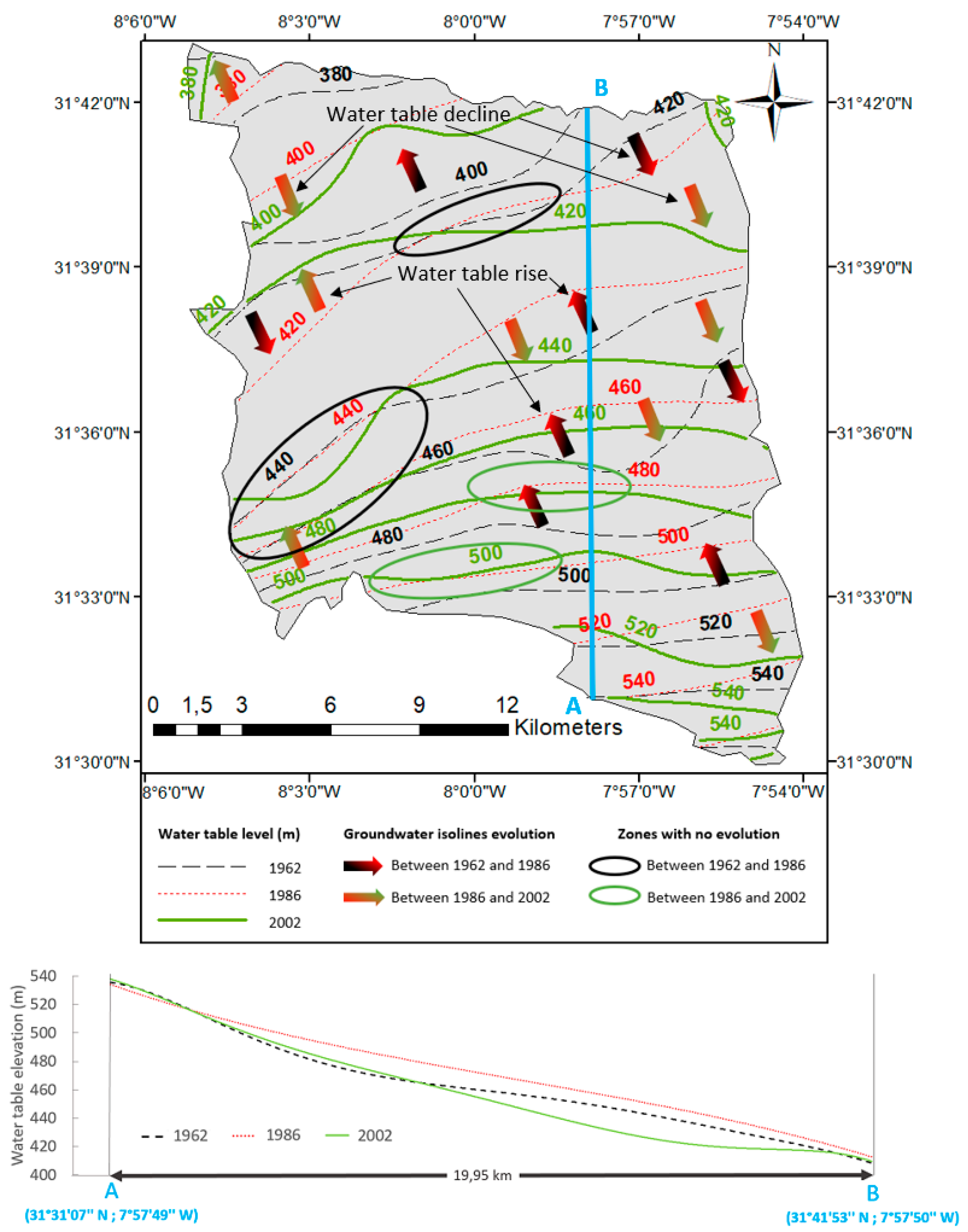
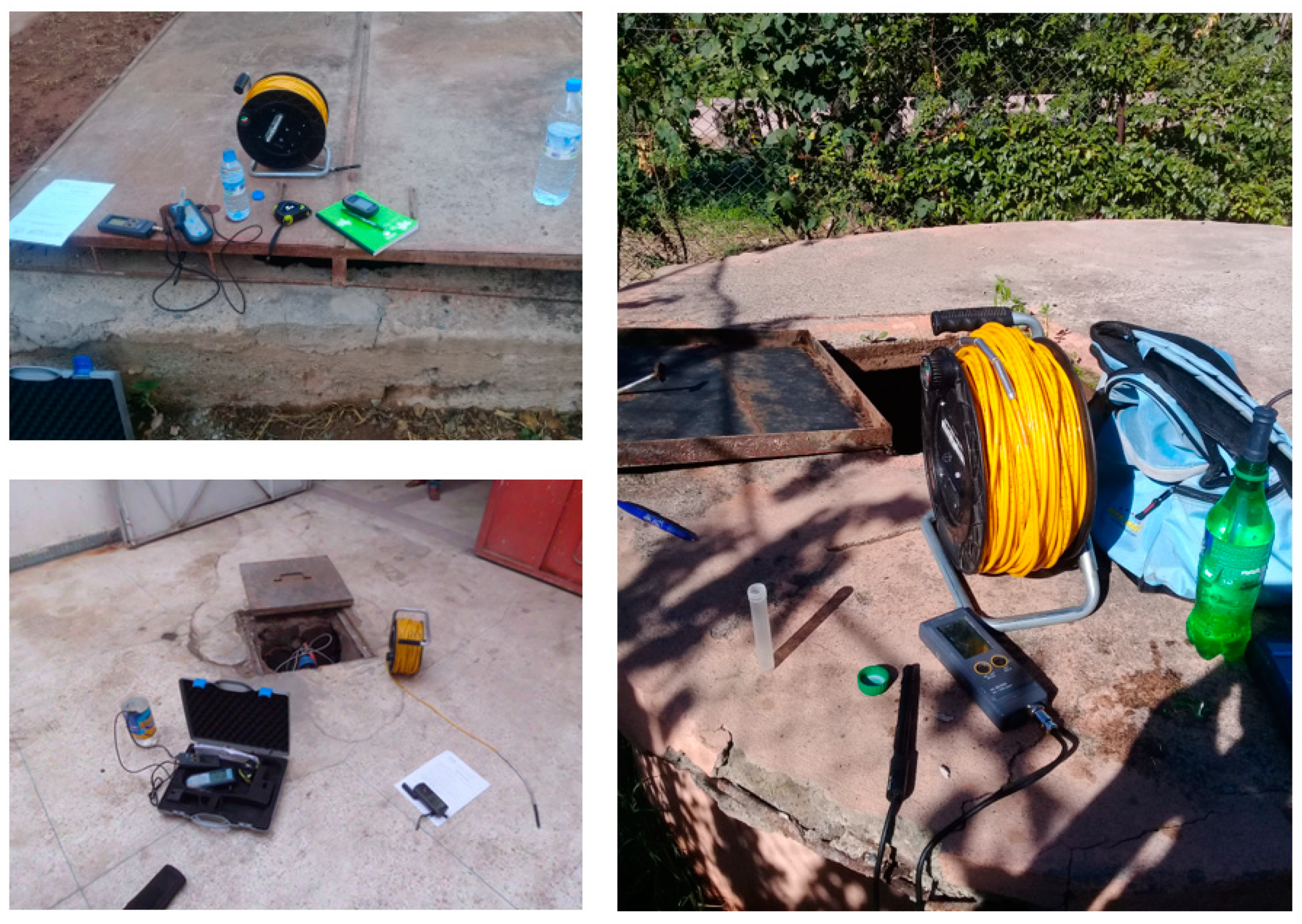
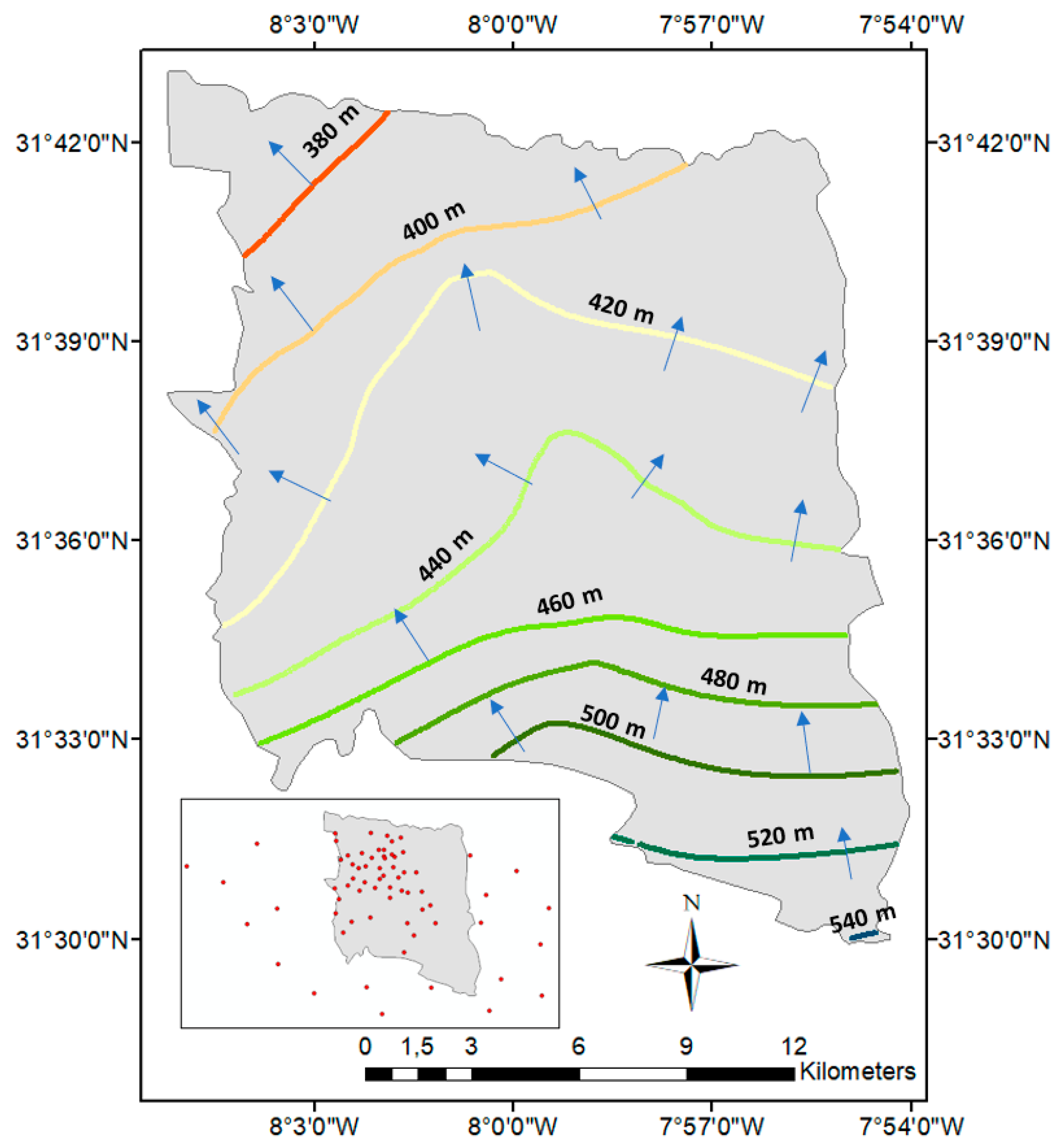
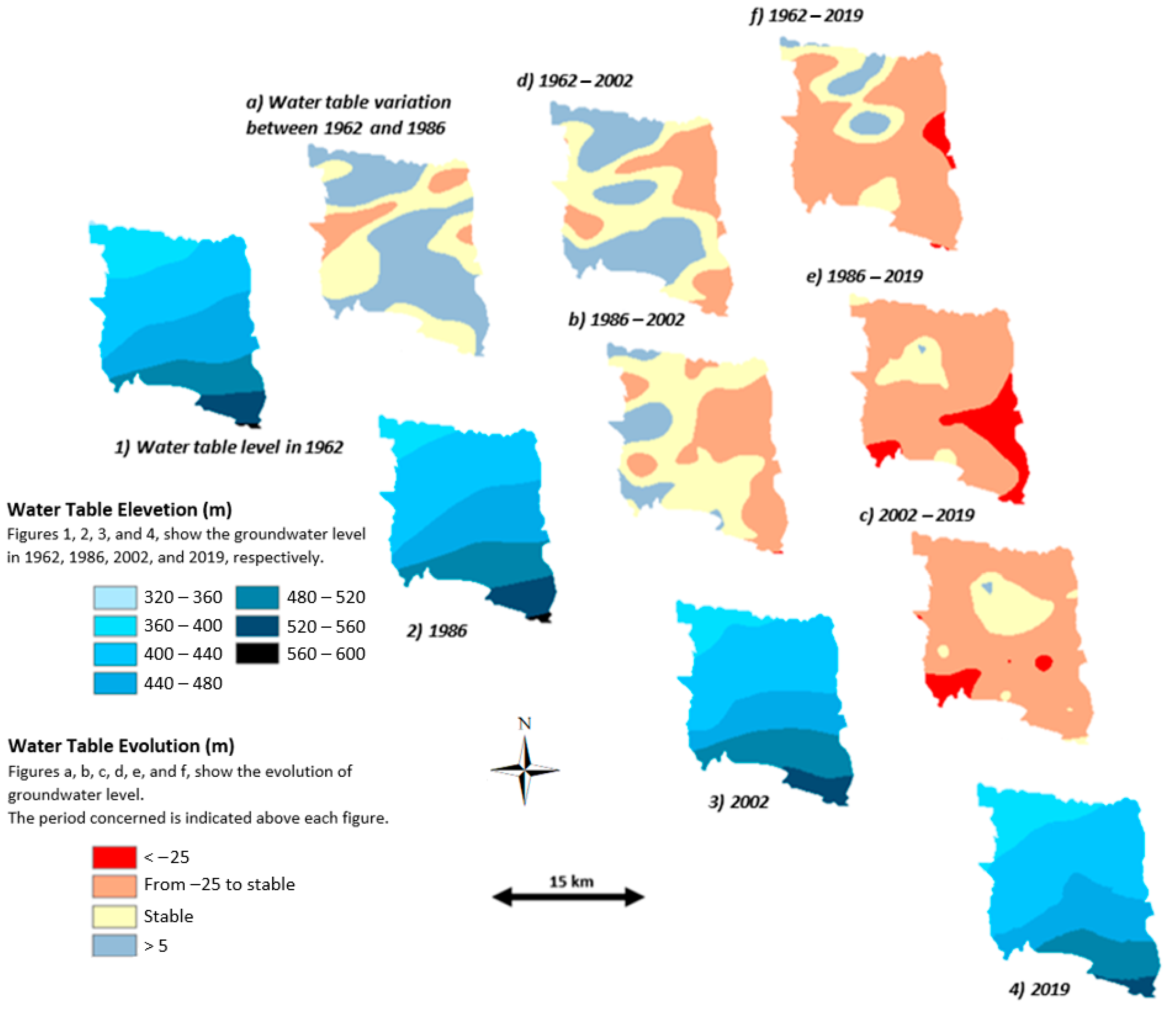
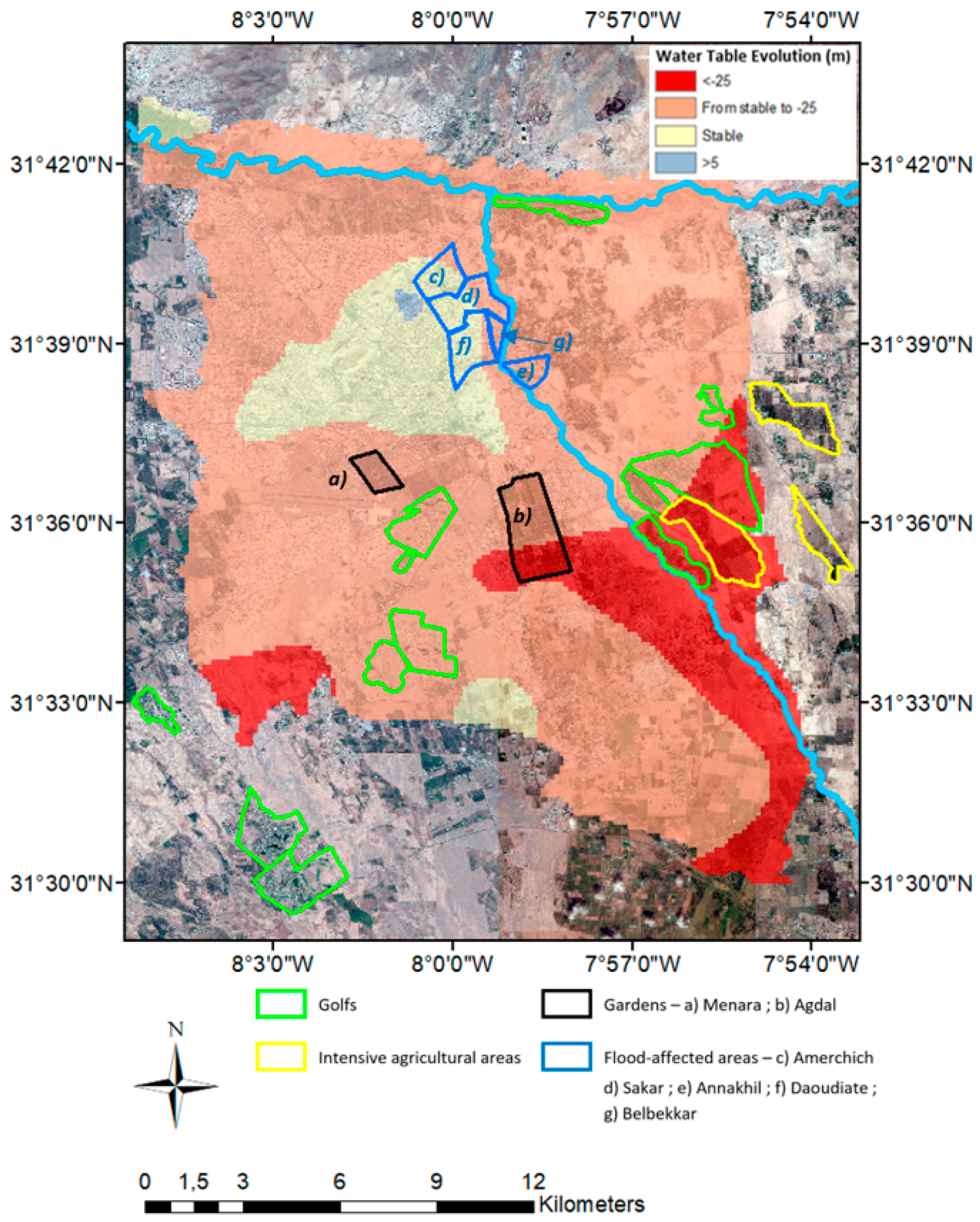

 |
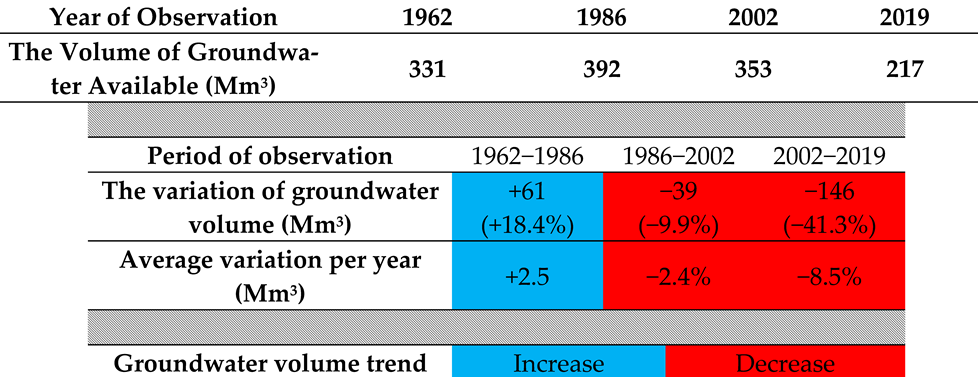 |
Publisher’s Note: MDPI stays neutral with regard to jurisdictional claims in published maps and institutional affiliations. |
© 2021 by the authors. Licensee MDPI, Basel, Switzerland. This article is an open access article distributed under the terms and conditions of the Creative Commons Attribution (CC BY) license (https://creativecommons.org/licenses/by/4.0/).
Share and Cite
Analy, M.; Laftouhi, N.-E. Groundwater Depletion in an Urban Environment under Semiarid Climate and Persistent Drought–City of Marrakesh (Morocco). Water 2021, 13, 3253. https://doi.org/10.3390/w13223253
Analy M, Laftouhi N-E. Groundwater Depletion in an Urban Environment under Semiarid Climate and Persistent Drought–City of Marrakesh (Morocco). Water. 2021; 13(22):3253. https://doi.org/10.3390/w13223253
Chicago/Turabian StyleAnaly, Mohammed, and Nour-Eddine Laftouhi. 2021. "Groundwater Depletion in an Urban Environment under Semiarid Climate and Persistent Drought–City of Marrakesh (Morocco)" Water 13, no. 22: 3253. https://doi.org/10.3390/w13223253
APA StyleAnaly, M., & Laftouhi, N.-E. (2021). Groundwater Depletion in an Urban Environment under Semiarid Climate and Persistent Drought–City of Marrakesh (Morocco). Water, 13(22), 3253. https://doi.org/10.3390/w13223253






